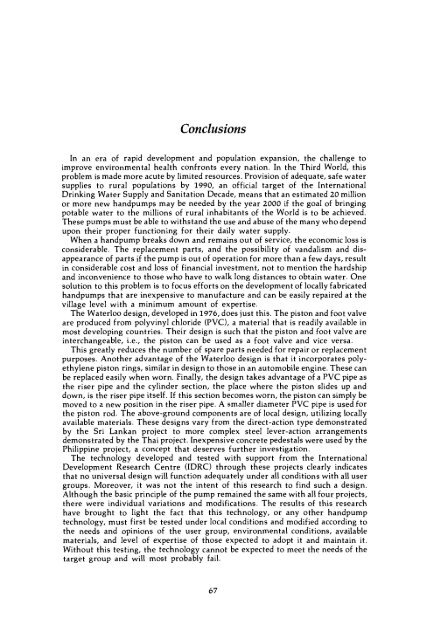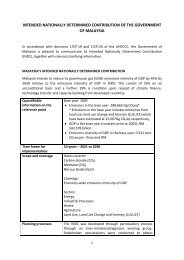RP-01638
RP-01638
RP-01638
Create successful ePaper yourself
Turn your PDF publications into a flip-book with our unique Google optimized e-Paper software.
Conclusions<br />
In an era of rapid development and population expansion, the challenge to<br />
improve environmental health confronts every nation. In the Third World, this<br />
problem is made more acute by limited resources. Provision of adequate, safe water<br />
supplies to rural populations by 1990, an official target of the International<br />
Drinking Water Supply and Sanitation Decade, means that an estimated 20 million<br />
or more new handpumps may be needed by the year 2000 if the goal of bringing<br />
potable water to the millions of rural inhabitants of the World is to be achieved.<br />
These pumps must be able to withstand the use and abuse of the many who depend<br />
upon their proper functioning for their daily water supply.<br />
When a handpump breaks down and remains out of service, the economic loss is<br />
considerable. The replacement parts, and the possibility of vandalism and disappearance<br />
of parts if the pump is out of operation for more than a few days, result<br />
in considerable cost and loss of financial investment, not to mention the hardship<br />
and inconvenience to those who have to walk long distances to obtain water. One<br />
solution to this problem is to focus efforts on the development of locally fabricated<br />
handpumps that are inexpensive to manufacture and can be easily repaired at the<br />
village level with a minimum amount of expertise.<br />
The Waterloo design, developed in 1976, does just this. The piston and foot valve<br />
are produced from polyvinyl chloride (PVC), a material that is readily available in<br />
most developing countries. Their design is such that the piston and foot valve are<br />
interchangeable, i.e., the piston can be used as a foot valve and vice versa.<br />
This greatly reduces the number of spare parts needed for repair or replacement<br />
purposes. Another advantage of the Waterloo design is that it incorporates polyethylene<br />
piston rings, similar in design to those in an automobile engine. These can<br />
be replaced easily when worn. Finally, the design takes advantage of a PVC pipe as<br />
the riser pipe and the cylinder section, the place where the piston slides up and<br />
down, is the riser pipe itself. If this section becomes worn, the piston can simply be<br />
moved to a new position in the riser pipe. A smaller diameter PVC pipe is used for<br />
the piston rod. The above-ground components are of local design, utilizing locally<br />
available materials. These designs vary from the direct-action type demonstrated<br />
by the Sri Lankan project to more complex steel lever-action arrangements<br />
demonstrated by the Thai project. Inexpensive concrete pedestals were used by the<br />
Philippine project, a concept that deserves further investigation.<br />
The technology developed and tested with support from the International<br />
Development Research Centre (IDRC) through these projects clearly indicates<br />
that no universal design will function adequately under all conditions with all user<br />
groups. Moreover, it was not the intent of this research to find such a design.<br />
Although the basic principle of the pump remained the same with all four projects,<br />
there were individual variations and modifications. The results of this research<br />
have brought to light the Tact that this technology, or any other handpump<br />
technology, must first be tested under local conditions and modified according to<br />
the needs and opinions of the user group, environmental conditions, available<br />
materials, and level of expertise of those expected to adopt it and maintain it.<br />
Without this testing, the technology cannot be expected to meet the needs of the<br />
target group and will most probably fail.<br />
67



